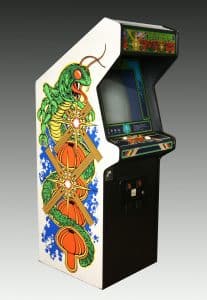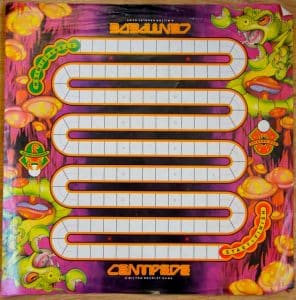 In 1981, Atari released Centipede—a shoot ‘em up arcade game comprised of pixilated creepy-crawlies—created by Ed Logg and Dona Bailey, one of the first female game designers. To play the game, a player used a trackball controller and a single firing button to shoot at a large centipede as it wound its way down the screen and through a field of mushrooms. The player also needed to steer clear of spiders, fleas and scorpions. The game quickly became one of Atari’s most well-liked 8-bit games. Traditional game manufacturers recognized the popularity of Centipede, and in 1983, Milton Bradley released a board game interpretation. To learn more about what it takes to create such an adaptation, I had the pleasure of discussing its evolution with the board game’s designer, Bruce Whitehill.
In 1981, Atari released Centipede—a shoot ‘em up arcade game comprised of pixilated creepy-crawlies—created by Ed Logg and Dona Bailey, one of the first female game designers. To play the game, a player used a trackball controller and a single firing button to shoot at a large centipede as it wound its way down the screen and through a field of mushrooms. The player also needed to steer clear of spiders, fleas and scorpions. The game quickly became one of Atari’s most well-liked 8-bit games. Traditional game manufacturers recognized the popularity of Centipede, and in 1983, Milton Bradley released a board game interpretation. To learn more about what it takes to create such an adaptation, I had the pleasure of discussing its evolution with the board game’s designer, Bruce Whitehill.
In the 1970s, Bruce dealt in what he summarized as “unusual antiques,” including old games. His interest in the history and development of the games led him to Milton Bradley. While speaking with a company representative, he learned that Milton Bradley was seeking a new game designer, and although Bruce had no formal design training he applied for and got the job.
When Milton Bradley obtained licensing rights to Centipede, the company tasked Bruce with creating a board game version. Bruce had had little interaction with video games. “I knew the classics like Pac Man and Donkey Kong, and even had played Centipede,” he recalled. To familiarize himself with Centipede, Bruce went to the local arcade. Unable to survive game play long enough to advance to higher levels and to get a strong grasp of the mechanics, Bruce quickly determined another course of action.
“I saw a young boy playing a different game on one of the other machines and doing very well,” Bruce noted. “’Do you know Centipede?,” Bruce inquired. When the boy confirmed, Bruce asked, “If I pay for your games, would you explain to me what you’re doing and what you’re trying to do?” The boy was thrilled to have an opportunity to play free games and with this demonstration, Bruce gained the necessary knowledge to begin creating a two-dimensional version of Centipede. He designed a board with a snake-like design and several movable pieces, including a spider and a scorpion, two centipedes, mushrooms, and two guns.
 Bruce included as many of the arcade game mechanics as possible. “You have to consider all the things that are going on in the arcade game and try to incorporate them into the board game,” Bruce explained. “There’s the moving of the centipede, the shooting, the ‘killing’ of centipede segments, and the various elements that are moved or removed, consisting of the mushrooms, the scorpion and the spider.” In the arcade game, events happen in real time, but to make the board game work, Bruce designed a spinner to dictate each action. “You need to determine how often you want something to happen,” he said. “In other words, you have to work out mathematically how many times each action will occur in reference to every other action.” For example, since the game relies most heavily on the movement of the centipede, Bruce allocated the most space on the spinner for that action.
Bruce included as many of the arcade game mechanics as possible. “You have to consider all the things that are going on in the arcade game and try to incorporate them into the board game,” Bruce explained. “There’s the moving of the centipede, the shooting, the ‘killing’ of centipede segments, and the various elements that are moved or removed, consisting of the mushrooms, the scorpion and the spider.” In the arcade game, events happen in real time, but to make the board game work, Bruce designed a spinner to dictate each action. “You need to determine how often you want something to happen,” he said. “In other words, you have to work out mathematically how many times each action will occur in reference to every other action.” For example, since the game relies most heavily on the movement of the centipede, Bruce allocated the most space on the spinner for that action.
Milton Bradley’s Centipede sold well, and Bruce considered the game a success, though he assumes that fans of the arcade game “may have tried it once or twice, but then they probably went back to the high-speed, action-packed, noisy arcade game. Centipede the board game was, I think, more for people like me—those who could never do that well on the arcade game but could hold their own against another player on the dining room table.”



